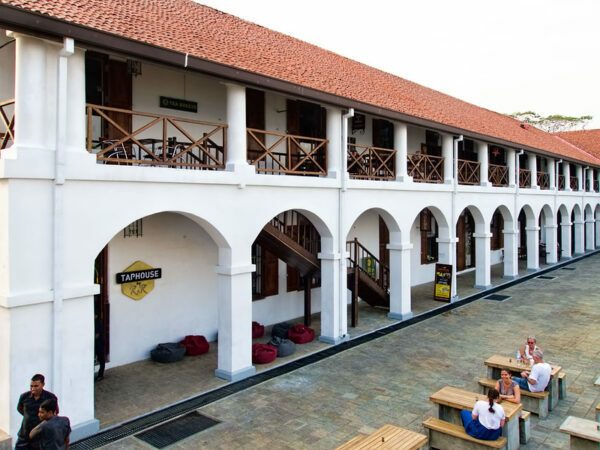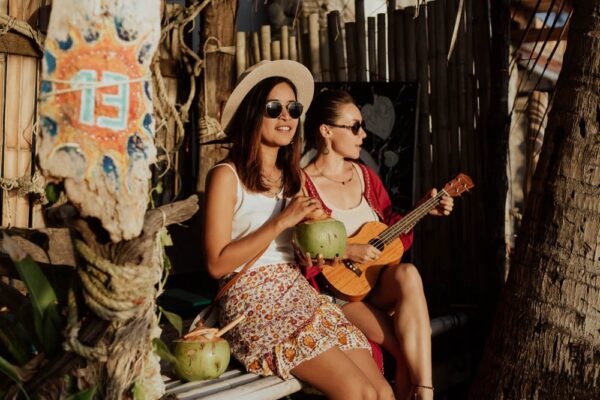Galle beaches are noted for their lovely sandy unspoilt shoreline. The Galle Fort holds a distinct place among the colonial-era fortifications. It has also gained prominence over nearly five decades as a living fortified city, where people live and do their daily activities. This historic, culturally diverse town has cobblestoned lanes lined with cafes, bistros, restaurants, boutique retail establishments, and more.
Top 12 Places to visti in Galle, Sri Lanka
- Galle fort
- Fort Lighthouse
- Clock Tower
- All Saints Anglican Church
- Flag Rock
- Old Town of Galle
- Unawatuna Beach
- Galle fort Old Gate
- National Maritime Museum
- Unawatuna Beach
- Sinharaja Forest Reserve
- Meeran Mosque
Ramparts of Galle Fort
Galle Fort, also known as the Dutch Fort, is a Portuguese castle built in 1588 in the Bay of Galle on Sri Lanka’s southwestern coast, which is a one of the top place that you can visit in Galle, Sri Lanka. The Galle Fort is a UNESCO World Heritage Site and Asia’s largest existing European-built stronghold. Galle Dutch Fort was designated a World Heritage Site by UNESCO in 1988 under the name Old Town of Galle and its Fortifications. The Galle Fort is now a maze of narrow streets packed with modest residences, restaurants, stores, villas, and boutique hotels, and it is a very fascinating area to explore. The fort is placed in a highly favorable and scenic location, surrounded on three sides by water, and its walls are in astonishingly good shape considering their antiquity.
This castle contains 14 bastions that remain the best-preserved and finest example of a European-built walled city in Asia, showcasing a blend of European architectural features with South Asian practices. It has a total size of 52 hectares within the walls. The Portuguese, headed by Lorenzo de Almeida, made their first arrival in Ceylon in 1505, and constructed a temporary fort in Galle.
When the Dutch captured Sri Lanka in 1640, they seized the Galle fort and reconstructed it with further extensions and reinforcements. It was then converted into their facility. They improved the fort’s protection by adding moats, trusses, and sentry posts.
The Dutch turned over the fort of Galle to the English after the defeat of Colombo in 1796. Although some homes within the walled city are still held by diverse Dutch people as well as indigenous Sri Lankans, The Galle fort is still home to a multi-ethnic and multi-religious community today.

Dutch Hospital
As the name implies, the Dutch Hospital, now home to many trendy boutiques and excellent eating venues, is where the sick used to come in colonial times to presumably rehabilitate and recover.
Although determining the exact year of building of the Dutch Hospital is challenging. The Dutch Hospital was founded in 1681, according to the documents of Christopher Schweitzer, a German national serving in the Dutch army. The creek adjacent to the hospital was swamped with British colonists after the British captured Sri Lanka.
Following a series of restorations that preserved the building’s historic architecture, the Galle Dutch Hospital was publicly reopened as a shopping and dining area in 2014. Inside, there are numerous restaurants, bars, coffee shops, and souvenir shops spread throughout both decks, as well as breathtaking views of the ocean.

Galle Fort Lighthouse
The Pointe de Galle Lighthouse, often known as the Galle Lighthouse, was built in 1848 and is Sri Lanka’s oldest lighthouse. The original lighthouse had a glass prism set within a mercury bath, which kept the lamp level and allowed it to rotate freely.
The original lighthouse was destroyed by a devastating fire in 1934. This prompted the construction of a new lighthouse in 1939, which stands 26.5 meters tall and is placed within the Galle Fort. The Sri Lanka Ports Authority continues to operate it as a lighthouse. Even though you cannot enter, it is a must-see at Galle Fort. The best time to visit the lighthouse is at sunset.

Galle Fort Clock Tower
The Clock Tower, located just inside the strong stone walls of Galle Fort, is one of the city’s most recognizable landmarks and most photographed monuments. Founded in 1883, The clock tower’s design was influenced by the designs of John Henry Guess Landon. It is a four-story tower with a height of 25 meters. The Galle clock tower was built to celebrate the services of distinguished colonial surgeon and legislative council member Dr Peter Daniel Anthonisz. Despite its age of about 200 years, the Galle Fort clock tower still keeps perfect time.

Angilican All Saints Church in Galle Fort
All Saints Anglican Church, which was built in the superb Gothic Revival architecture and opened in 1871, is another attraction to be found within Galle Fort. The church is designed in the shape of a cross and is supported by stone columns. Stained glass windows surround the altar, allowing light to filter into the securely covered interior. The cool temperature and serene environment make it ideal for some quiet meditation away from the city’s heat and noise.

Beaches in Unawatuna
Unawatuna, one of Sri Lanka’s best and most popular beaches, is the ideal place to relax in the sun while taking in the breathtaking surroundings. While golden sands are undoubtedly stunning, with the waves of the ocean, Unawatuna is particularly well-known for the variety of watersports available.
Unawatuna is popular among scuba divers and snorkelers due to the abundance of magnificent coral reefs and shipwrecks off the coast. Turtles may even come to nest on the shore at certain periods of the year. In addition, there are numerous laid-back tiny restaurants, bars, and hotels to pick from. If you want to mix a beach vacation with the history and culture of Galle, this is a terrific spot to stay.
Jungle Beach Unawatuna
Jungle Beach, one of Unawatuna’s most peaceful beaches, is a lovely stretch of golden sands from which to see the majesty of Rumassala Hill on one side and the breathtaking Indian Ocean on the other.The Jungle Beach is also rich in biodiversity, with endemic birds like as kingfishers, egrets, herons, and sandpipers. Mammals and reptiles found in the Jungle Beach include the purple-faced langur and the Sri Lankan water monitor.

Best Time to Visit Galle, Sri Lanka
It is recommended to visit Galle during the months of December and April. The monsoon season, which lasts from May to September, should be avoided.
To avoid the tourist swarms, visit Galle Fort early in the day, especially in the busy months of February, March, and April. Additionally, you have to return in the evening to see the breathtaking sunset over the raging ocean from the Fort’s Wall.
How to Reach Galle from Colombo
Galle is 124 kilometers from Colombo and takes roughly two hours to arrive via the Southern Expressway. Both the rail and the express bus might take between 4.5 and 5 hours.
From Colombo to Galle by Bus
From Colombo Airport, board bus 187 to Colombo Central Bus Station. You will have to switch buses there. Any bus heading toward Galle, Tangalle, Matara, is an option.
From Colombo to Galle by Train
You must first travel to Colombo Fort Railway Station in order to get a second or third-class train ticket, Galle. Expect to have a difficult time finding a seat on this trip because the trains on this route are typically crowded.
Where to Stay in Galle
It is recommended to visit Galle during the months of December and April. The monsoon season, which lasts from May to September, should be avoided.
- The Heritage Galle Fort
- Jetwing Lighthouse
- Windy Garden
- Deltora Villa
- Fort Bazaar
Where to Eat in Galle
Galle Fort, found by the Portuguese (16th century) and defended by the Dutch (18th century), is a taste of Europe in Sri Lanka, with its colonial fort, colorful and narrow cobbled alleyways, artsy vintage boutiques, sidewalk cafés, and restaurants.
- Pedlar’s Inn Cafe: Seafood platter and pasta
- The Heritage Cafe & Bistro at Amangalla: High tea, cakes, and pastries
- Poonie’s Kitchen: Thali Salad and carrot cake
- the Isle of Gelato: Gelato and sorbet in exotic flavors
Best Time to Visit Galle, Sri Lanka
If you stay in Galle, you won’t have to worry about moving about. Simply walk anywhere. To get to adjacent places like Unawatuna, you can take a bus or a tuk tuk from the bus station immediately outside Galle Fort. Galle and Mirissa are connected by direct buses.
Guided tours of Sri Lanka that also Visit Galle
Sri Lanka is not a tough country to tour around, but if you don’t like planning or prefer to leave it to the pros, Ceylon Hunt provides some fantastic guided tours.
- Amazing Sri Lanka– this 8 day Ceylon Hunt tour is excellent for Getaway travellers.
- Discover Sri Lanka– a 12 day Ceylon Hunt tour perfect for a European Travellers.
- Most of Sri Lanka– an 15 day CeylonHunt tour goes to all the most popular places to visit in the country, including Galle.
Whatever you decide, you will not be disappointed in Galle, where the food is affordable and delicious, the people are nice and welcoming, and the scenery is breathtaking. We hope you enjoyed this blog on Galle, Sri Lanka! If you have any questions, please send us a message or leave a comment below so that we can respond!
Image courtesy of Sergei Gussev Dan Lundberg via creative commons licenses. some rights reserved.
Ceylon Hunt has tour packages which facilitate your tour to Galle and you can check them going through our tour packages or make the resevations through our website.







